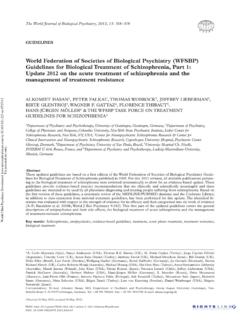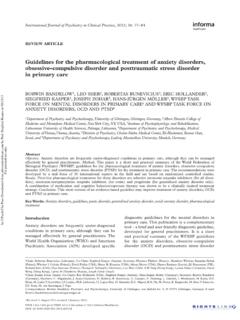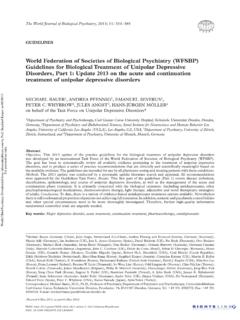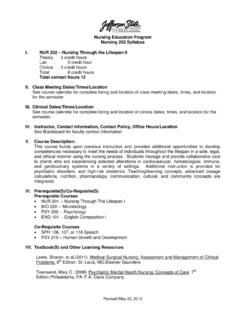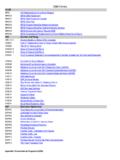Transcription of The World Federation of Societies of Biological …
1 The World Journal of Biological Psychiatry, 2013; 14: 154 219. GUIDELINES. The World Federation of Societies of Biological Psychiatry (WFSBP). Guidelines for the Biological Treatment of Bipolar Disorders: Update 2012 on the long-term treatment of bipolar disorder HEINZ GRUNZE1,2, EDUARD VIETA3, GUY M. GOODWIN4, CHARLES BOWDEN5, World J Biol Psychiatry Downloaded from by Prof. Siegfried Kasper on 03/13/13. RASMUS W. LICHT6, HANS-J RGEN M LLER2, SIEGFRIED KASPER7 on behalf of the WFSBP Task Force on Treatment Guidelines for Bipolar Disorders . 1 Newcastle University, Institute of Neuroscience, Newcastle upon Tyne, UK, 2 Ludwig-Maximilians-University, Department of Psychiatry, Munich, Germany, 3 Bipolar Disorders Programme, Institute of Neuroscience, Hospital Clinic, University of Barcelona, IDIBAPS, CIBERSAM, Barcelona, Catalonia, Spain, 4 University of Oxford, Department of Psychiatry,Warneford Hospital, Oxford, UK, 5 University of Texas Health Science Center, Department of Psychiatry, San Antonio, TX, USA, 6 Mood Disorders Research Unit, Aarhus University Hospital, Risskov, Denmark, 7 Medical University of Vienna, Department of Psychiatry and Psychotherapy,Vienna, Austria For personal use only.
2 Abstract Objectives. These guidelines are based on a first edition that was published in 2004, and have been edited and updated with the available scientific evidence up to October 2012. Their purpose is to supply a systematic overview of all sci- entific evidence pertaining to the long-term treatment of bipolar disorder in adults. Methods. Material used for these guidelines are based on a systematic literature search using various data bases. Their scientific rigor was categorised into six levels of evidence (A F) and different grades of recommendation to ensure practicability were assigned. Results. Maintenance trial designs are complex and changed fundamentally over time; thus, it is not possible to give an overall recommendation for long-term treatment.
3 Different scenarios have to be examined separately: Prevention of mania, depression, or an episode of any polarity, both in acute responders and in patients treated de novo. Treatment might differ in Bipolar II patients or Rapid cyclers, as well as in special subpopulations. We identified several medications preventive against new manic episodes, whereas the current state of research into the prevention of new depressive episodes is less satisfactory. Lithium continues to be the substance with the broadest base of evidence across treatment scenarios. Conclusions. Although major advances have been made since the first edition of this guideline in 2004, there are still areas of uncertainty, especially the prevention of depressive episodes and optimal long-term treatment of Bipo- lar II patients.
4 Key words: Bipolar disorder; Maintenance; Prophylaxis; Pharmacotherapy; Antipsychotics *WFSBP Task Force on Treatment Guidelines for Bipolar Disorders: Siegfried Kasper (Chairman, Austria), Guy Goodwin (Co-Chairman, UK), Charles Bowden (Co-Chairman, USA), Heinz Grunze (Secretary, UK), Hans-J rgen M ller (WFSBP Past-President, Germany), Rasmus W. Licht (Denmark), Eduard Vieta (Spain), Hagop Akiskal (USA), Jos Luis Ayuso-Gutierrez (Spain), Michael Bauer (Germany), Per Bech (Denmark), Michael Berk (Australia), Istvan Bitter (Hungary), Graham Burrows (Australia), Joseph R. Calabrese (USA), Giovanni Cassano (Italy), Marcelo Cetkovich-Bakmas (Argentina), John C. Cookson (UK), Nicol I. Ferrier (UK), Maria Luisa Figueira (Portugal), Wagner F. Gattaz (Brazil), Frederik K.
5 Goodwin (USA), Gerhard Heinze (Mexico), Chantal Henry (France), Teruhiko Higuchi (Japan), Robert M. Hirschfeld (USA), Cyril Hoeschl (Czech Republic), Edith Holsboer-Trachsler (Switzerland), Kay Redfield Jamison (USA), Cornelius Katona (UK), Martin Keller (USA), Lars Vedel Kessing (Denmark), E. Kostukova (Russia), Hever Kruger (Peru), Parmanand Kulhara (India), Veronica Larach (Chile), Odd Lingjaerde (Norway), Henrik Lublin (Denmark), Mario Maj (Italy), Julien Mendlewicz (Belgium), Roberto Miranda Camacho (Mexico), Philip B. Mitchell (Australia), Sergey Mosolov (Russia), Stuart Montgomery (UK), Charles Nemeroff (USA), Willem Nolen (The Netherlands), Timucin Oral (Turkey), Eugene S. Paykel (UK), Robert M. Post (USA), Stanislaw Puzynski (Poland), Zoltan Rihmer (Hungary), Janusz K.
6 Rybakowski (Poland), Simavi Vahip (Turkey), Per Vestergaard (Denmark), Peter C. Whybrow (USA), Kazuo Yamada (Japan). Correspondence: Prof. Dr. Heinz Grunze, Institute of Neuroscience, Department of Psychiatry, RVI, Newcastle University, Newcastle upon Tyne, NE1 4LP, UK. Tel: 44 191 282 5765. Fax: 44 191 222 6162. E-mail: (Received 22 January 2013 ; accepted 23 January 2013). ISSN 1562-2975 print/ISSN 1814-1412 online 2013 Informa Healthcare DOI: Bipolar Maintenance Guidelines 155. Abbreviations: AE, adverse event; AED, antiepileptic drug; aims , abnormal involuntary movement scale ; BARS, Barnes Akathisia Rating scale ; CANMAT, Canadian Network for Mood and Anxiety Treatments, CBT, cognitive behavioural therapy; CE, category of evidence; CGI-BP, Clinical Global Impression Bipolar; CI, confidence interval; DBS, deep brain stimulation; DDD, defined daily dose; DSM, Diagnostic and Statistical Manual; DSS, Depressive Symptom scale ; ECT, electroconvulsive therapy; EPS, extrapyramidal motor symptoms; ER, extended release; ESRS, Extrapyramidal Symptoms Rating scale ; FE, further evidence; FEW, free and easy wanderer; FDA, US Food and Drug administration; GAS, Global Assessment scale ; HAM-D, Hamilton Rating scale for Depression.
7 HR, hazard ratio; ICD, International Classification of Diseases; IDS, Inventory of Depressive Symptoms; ISBD, International Society for Bipolar Disorder; KM, Kaplan Meier; LAI, long acting injectable; LOCF, last observation carried forward; MADRS, Montgomery Asberg Depression Rating scale ; MDE, major depressive episode; MOAT- BD, Multistate Outcome Analysis of Treatments in Bipolar Disorder; MRS, Mania Rating scale ; NNT, numbers needed to treat; OFC, olanzapine fluoxetine combination; OR, odds ratio; PA, preventive agent; PES, prevention of TEE in enriched samples; PR, practicability; PRC, prevention of TEE in rapid cyclers; PSu, prevention of suicide;. RC, rapid cycling; RCT, randomized controlled trial; RG, recommendation grade; RR, relative risk; rTMS, repetitive transcranial magnetic stimulation; SAS, Simpson Angus Extrapyramidal Side Effect scale ; SD, standard deviation.
8 SFBN, Stanley Foundation Bipolar Network; ST, safety and tolerability; STEP-BD, Systematic Treatment Enhancement Program for Bipolar Disorder; TAU, Treatment as usual; TEAS, treatment emergent affective switch;. World J Biol Psychiatry Downloaded from by Prof. Siegfried Kasper on 03/13/13. TEE, treatment emergent episode; VNS, vagus nerve stimulation; WFSBP, World Federation of Societies of Biological Psychiatry; YMRS, Young Mania Rating scale . Preface and disclosure statement reducing complexity, this guideline series deals with acute and long-term treatment separately. This practice guideline for the Biological , mainly Although it is of great importance to control the pharmacological maintenance treatment of bipolar acute manifestations of the illness as rapidly and disorder was developed by an international Task effectively as possible, the real key issue is successful Force of the World Federation of Societies of Bio- maintenance treatment, , the prevention of new logical Psychiatry (WFSBP) and is part of a series episodes and all kinds of complications and disable- covering the acute treatment of mania, bipolar For personal use only.
9 Ment. In fact, bipolar disorder ranks worldwide depression and maintenance treatment of bipolar among the top ten of the most disabling disorders in disorder. The preparation of these guidelines has working age adults (The World Health Organisation not been financially supported by any commercial 2002), and the socioeconomic impact is considerable organization. (Hakkaart-van Roijen et al. 2004; Runge and Grunze This guideline has mainly been developed by psy- 2004; Young et al. 2011). chiatrists and psychotherapists who are in active Starting with Kraepelin (1921), several long-term clinical practice. Experts of the task force were observational studies have demonstrated that the selected according to their expertise and with the duration of the symptom-free interval is inversely aim to cover a multitude of different cultures.
10 Linked to the number of previous episodes (Zis et al. In addition, some contributors are primarily 1980; Angst 1981; Roy-Byrne et al. 1985; Kessing involved in research or other academic endeavours. It 1998a). Likewise, aspects of cognitive impairment is possible that through such activities some contrib- are associated with increasing episode frequency utors have received income related to medicines dis- (Kessing 1998b; Lebowitz et al. 2001; Lopez-Jaramillo cussed in this guideline. A number of mechanisms are et al. 2010a) leading to lasting psychosocial and in place to minimize the potential for producing work impairment (Dickerson et al. 2004; Wingo biased recommendations due to conflicts of interest. et al. 2009). Subsyndromal symptoms may also con- Some drugs recommended in the present guide- tribute significantly to long-term disability in indi- line may not be available in all countries, and vidual patients (Coryell et al.)

